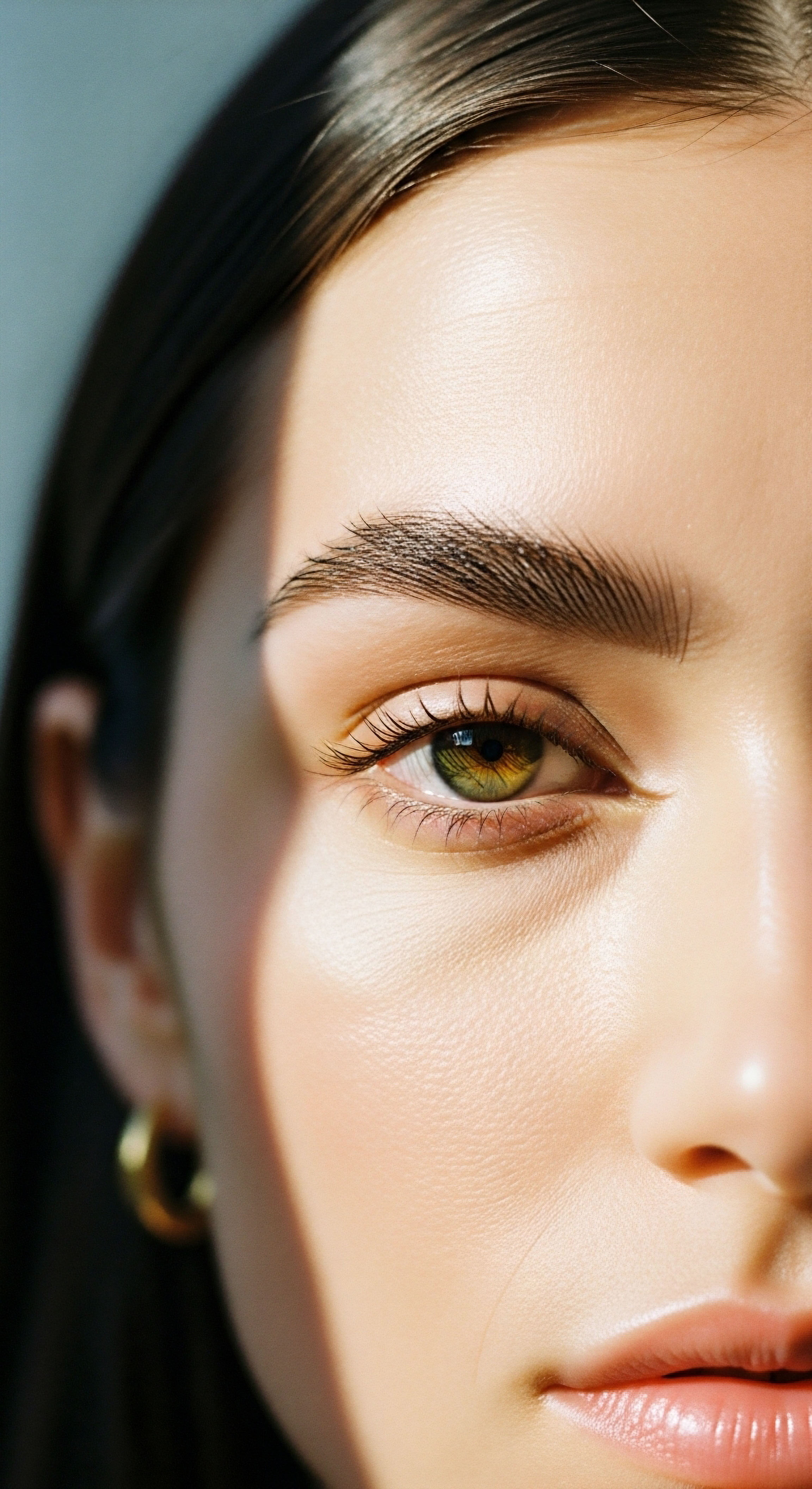

Fundamentals
You have likely observed subtle shifts in the mirror, moments where the light catches new fine lines around your eyes or your smile seems to hold a different kind of tension. These perceptions are real, and they originate from a place far deeper than the skin’s surface. The vitality you see in your reflection is a direct expression of your body’s internal biological state, an intricate communication network orchestrated by your endocrine system. Hormones are the primary messengers in this system, and their balance dictates the health, resilience, and appearance of every cell, including those that form the foundation of your eyes and smile.
Understanding how hormonal optimization protocols Meaning ∞ Hormonal Optimization Protocols are systematic clinical strategies designed to restore or maintain optimal endocrine balance. affect your appearance begins with appreciating the profound connection between these chemical signals and the structural components of your face. Think of your skin as a dynamic, living fabric. Its texture, thickness, and ability to retain moisture are all governed by specific hormonal inputs. Estrogen, for instance, is a master regulator of skin health.
It directly communicates with specialized cells in the dermis called fibroblasts, instructing them to produce collagen. Collagen is a protein that provides the essential scaffolding for your skin, giving it firmness and structure. When estrogen levels are optimal, this collagen matrix is dense and well-organized, resulting in smooth, supple skin that effectively reflects light, contributing to a luminous complexion around the eyes and mouth.
Simultaneously, estrogen plays a foundational role in skin hydration Meaning ∞ Skin hydration refers to the critical water content present within the epidermal layers, primarily the stratum corneum. by promoting the synthesis of hyaluronic acid, a molecule that can hold many times its weight in water. This process is what gives skin its plump, dewy quality. As hormonal levels shift, particularly during perimenopause and menopause, the decline in estrogen signaling leads to a direct reduction in both collagen and hyaluronic acid Meaning ∞ Hyaluronic Acid is a naturally occurring anionic glycosaminoglycan, a polysaccharide widely distributed throughout connective, epithelial, and neural tissues. production.
The result is skin that becomes thinner, drier, and less elastic, which manifests visually as fine lines, a loss of volume, and a complexion that appears less vibrant. The delicate skin around theeyes is often the first place these changes become apparent.
The aesthetic changes you perceive in your face are tangible feedback from your body’s underlying cellular and hormonal systems.

The Structural Integrity of Your Smile
The impact of your endocrine system extends beyond the skin to the very architecture of your smile. The health of your gums and the density of your jawbone are also under hormonal influence. Estrogen has a protective, anti-inflammatory effect on periodontal tissues.
When estrogen levels decline, the oral environment can become more susceptible to inflammation and the bacteria that cause periodontal disease. This can lead to gum recession and sensitivity, altering the framework of your smile.
Furthermore, both estrogen and testosterone are integral to maintaining bone mineral density Meaning ∞ Bone Mineral Density, commonly abbreviated as BMD, quantifies the amount of mineral content present per unit area of bone tissue. throughout the body, including the mandible, or jawbone. A strong, dense jawbone provides the essential foundation for your teeth and anchors the muscles of the lower face. Hormonal depletion can contribute to a loss of this bone density, a process that can subtly alter the contours of your jawline and the stability of your smile over time.
In men, optimal testosterone levels contribute to a more defined and angular jawline, a feature associated with masculine facial structure, by supporting both bone density Meaning ∞ Bone density quantifies the mineral content within a specific bone volume, serving as a key indicator of skeletal strength. and muscle tone. When testosterone levels decrease, a condition known as hypogonadism, facial features can appear softer and less defined due to a combination of reduced muscle mass and changes in fat distribution.

What Is the Connection between Hormones and Eye Appearance?
The beauty of your eyes is a composite of several factors, each sensitive to hormonal regulation. Beyond the skin that frames them, the health of the ocular surface itself is dependent on endocrine balance. The tear film, which keeps the eyes moist and comfortable, is influenced by sex hormones. Hormonal fluctuations, especially the decline in androgens and estrogens, are linked to dry eye syndrome, a condition that can cause irritation, redness, and a tired appearance.
Women are more susceptible to dry eye, particularly during menopause, because of these significant hormonal shifts. Addressing the underlying hormonal imbalance can therefore directly contribute to clearer, more comfortable, and more vibrant-looking eyes.
In a very direct sense, hormonal health is the invisible architecture behind your most expressive features. The clarity of your eyes and the confidence of your smile are reflections of a well-regulated internal system. When we talk about hormonal optimization, we are discussing a process of recalibrating this system at a foundational level. The aesthetic benefits, such as smoother skin, brighter eyes, and a more robust smile, are the natural and authentic outcomes of restoring your body’s innate biological vitality.


Intermediate
Advancing from the foundational understanding of hormones and aesthetics, we can now examine the specific mechanisms and clinical protocols designed to address the age-related changes you observe. The journey into perimenopause Meaning ∞ Perimenopause defines the physiological transition preceding menopause, marked by irregular menstrual cycles and fluctuating ovarian hormone production. for women, or andropause for men, represents a significant shift in the body’s endocrine symphony. These transitions are not merely a decline in hormone quantity; they are a change in the body’s entire signaling environment. This biochemical shift has direct and measurable consequences for the tissues that create the beauty of your eyes and smile.
For women, the fluctuating and eventual decline of estrogen during perimenopause and menopause accelerates the degradation of the skin’s structural matrix. Scientific studies have quantified this change, showing that women can lose up to 30% of their skin’s collagen within the first five years after menopause. This loss is a direct result of diminished estrogen signaling to the ERβ receptors on fibroblast cells, which effectively slows down the collagen production factory.
The result is a quantifiable decrease in dermal thickness Meaning ∞ Dermal thickness refers to the measurable depth of the dermis, the vital layer of skin situated beneath the epidermis and above the subcutaneous tissue. of about 1.1% per year and a collagen reduction of 2% per year in postmenopausal women who are not on hormonal therapy. This process manifests as deepening crow’s feet, the formation of nasolabial folds, and a general loss of the skin’s ability to “snap back.”
Hormonal optimization protocols for women are designed to counteract these effects directly. The administration of bioidentical estrogen, often in topical or transdermal forms, replenishes the signals to the skin’s fibroblast cells, helping to stabilize and even increase collagen synthesis. Clinical evidence indicates that estrogen therapy can increase skin collagen Meaning ∞ Skin collagen comprises primary structural proteins within the dermal layer, predominantly Type I and Type III. by over 6% and dermal thickness by up to 30% after a year of consistent use. This restoration of the skin’s underlying support structure leads to a visible improvement in skin texture, firmness, and hydration.
Hormonal optimization protocols work by restoring the specific biochemical signals that command your cells to repair and rebuild tissues.

The Role of Testosterone in Facial Aesthetics
While often considered a male hormone, testosterone is also vital for women’s health and contributes significantly to facial aesthetics. In women, low-dose testosterone therapy, often administered as a weekly subcutaneous injection of Testosterone Cypionate (e.g. 0.1-0.2ml), supports muscle tone Meaning ∞ Muscle tone refers to the continuous, passive partial contraction of the muscles, or the resistance to passive stretch during resting state. and skin thickness. It helps maintain the integrity of the facial musculature, which provides support against gravitational sagging.
For men, Testosterone Replacement Therapy Meaning ∞ Testosterone Replacement Therapy (TRT) is a medical treatment for individuals with clinical hypogonadism. (TRT) is a cornerstone of addressing andropause. A typical protocol might involve weekly intramuscular injections of Testosterone Cypionate (e.g. 200mg/ml) to restore physiological levels. This therapy directly combats the facial changes associated with low testosterone, such as a softer jawline and puffier appearance. By reducing facial fat and increasing muscle tone, TRT can help restore a more defined, angular facial structure.
It is important to manage the potential conversion of testosterone to estrogen in men, a process called aromatization. This is why TRT protocols for men often include an aromatase inhibitor like Anastrozole, taken orally twice a week. This medication blocks the enzyme responsible for this conversion, preventing potential side effects like water retention, which could otherwise lead to a fuller face and counteract the desired aesthetic outcome. Additionally, medications like Gonadorelin may be used to maintain the body’s own testosterone production signals, ensuring a more balanced and holistic approach to hormonal recalibration.
The following table outlines the distinct and complementary roles of key hormones in facial aesthetics:
| Hormone | Primary Aesthetic Function in the Face | Effect of Deficiency | Therapeutic Goal of Optimization |
|---|---|---|---|
| Estrogen (in Women) | Stimulates collagen and elastin production, increases skin hydration through hyaluronic acid synthesis. | Thinner, drier skin; increased wrinkles; loss of firmness. | Restore dermal thickness and elasticity, improve skin moisture and texture. |
| Testosterone (in Men) | Maintains bone density of the jaw, supports facial muscle tone, reduces subcutaneous facial fat. | Softer jawline, rounder facial appearance, reduced facial hair. | Enhance jawline definition, improve muscle tone, achieve a leaner facial contour. |
| Testosterone (in Women) | Contributes to skin thickness and sebum production for natural moisture, supports facial muscle integrity. | Dryer skin, loss of subtle facial contours. | Improve skin hydration and tone, support underlying facial structure. |
| Progesterone (in Women) | Affects skin hydration and oil production, works in concert with estrogen. | Can contribute to dry, flaky skin. | Balance estrogen’s effects and improve skin hydration and suppleness. |

How Do Hormones Affect Oral and Ocular Health?
The beauty of a smile is deeply connected to the health of the tissues that support it. Estrogen deficiency Meaning ∞ Estrogen deficiency represents a physiological state characterized by insufficient levels of estrogen hormones, primarily estradiol, within the body. is a known risk factor for periodontal disease and alveolar bone loss in postmenopausal women. The decline in estrogen leads to a more pro-inflammatory state in the gums and reduces the signals for bone maintenance. Hormone replacement therapy Meaning ∞ Hormone Replacement Therapy, often referred to as HRT, involves the administration of exogenous hormones to supplement or replace endogenous hormones that are deficient or absent in the body. has shown beneficial effects by reducing gingival inflammation and helping to preserve the bone density of the jaw, providing a more stable and healthy foundation for your smile.
Similarly, the comfort and clarity of your eyes are tied to hormonal balance. The glands that produce the components of your tear film have receptors for both androgens and estrogens. A deficiency in these hormones can lead to Meibomian Gland Dysfunction, where the oily layer of the tear film is compromised, causing rapid tear evaporation and the symptoms of dry eye.
While the research on HRT for dry eye has produced varied results, some studies suggest that a combination of estrogen and progesterone may be less likely to cause dry eye than estrogen alone. For some individuals, restoring hormonal balance can improve tear film stability and reduce the redness and irritation that detract from the eyes’ natural sparkle.
The following list details some specific protocols used in hormonal optimization:
- TRT for Men ∞ Typically involves weekly intramuscular injections of Testosterone Cypionate, often paired with Anastrozole to control estrogen conversion and Gonadorelin to support natural hormonal signaling pathways.
- Hormone Therapy for Women ∞ May involve transdermal estrogen, oral progesterone (depending on menopausal status), and often low-dose weekly subcutaneous testosterone injections to support energy, libido, and tissue integrity.
- Growth Hormone Peptide Therapy ∞ Utilizes peptides like Sermorelin or Ipamorelin, which stimulate the pituitary gland to produce more of the body’s own growth hormone. This can enhance skin repair, collagen synthesis, and overall tissue regeneration.
These clinical strategies are designed to work with your body’s own systems. They aim to re-establish a physiological environment where your cells receive the necessary instructions to maintain their function, health, and vitality. The visible result is a more refreshed and resilient appearance that is an authentic reflection of improved systemic health.


Academic
An academic exploration of how hormonal optimization Meaning ∞ Hormonal Optimization is a clinical strategy for achieving physiological balance and optimal function within an individual’s endocrine system, extending beyond mere reference range normalcy. protocols influence facial aesthetics requires a systems-biology perspective, moving beyond isolated effects to understand the intricate crosstalk between the endocrine, integumentary, and musculoskeletal systems. The visible aging of the eyes and smile is a terminal manifestation of complex, interconnected cellular and molecular processes governed by the Hypothalamic-Pituitary-Gonadal (HPG) axis and its downstream hormonal effectors. At this level, we are not just observing changes in appearance; we are witnessing the macroscopic outcome of altered gene expression, protein synthesis, and inflammatory modulation within facial tissues.
The foundational mechanism involves the binding of steroid hormones, like estradiol and testosterone, to their cognate nuclear receptors within target cells—keratinocytes, fibroblasts, osteoblasts, and sebocytes. This hormone-receptor complex acts as a transcription factor, binding to hormone response elements on DNA to upregulate or downregulate the expression of specific genes. For example, in dermal fibroblasts, estradiol binding to estrogen receptor beta (ER-β) initiates the transcription of genes for COL1A1 and COL3A1, which encode for type I and type III collagen, respectively.
It also increases the expression of genes for elastin and hyaluronic acid synthase. A decline in circulating estradiol, as seen in menopause, leads to a transcriptional slowdown of these structural proteins, causing a well-documented decline in the biomechanical integrity of the dermal extracellular matrix.
The aesthetic impact of hormonal therapy is the surface-level expression of restored transcriptional activity in the genes governing tissue structure and repair.

Androgenic Regulation of Facial Architecture
The structural framework of the lower face, which is paramount to the aesthetics of the smile, is highly dependent on androgenic signaling. Testosterone and its more potent metabolite, dihydrotestosterone (DHT), exert powerful effects on both bone and muscle tissue. The mandible is a site of continuous bone remodeling, and androgens play a key role in this process. They stimulate periosteal apposition, which contributes to the radial growth and maintenance of cortical bone size and density.
This is why hypogonadal men often exhibit lower bone mineral density (BMD), particularly in trabecular-rich sites like the spine and potentially the jaw. TRT in hypogonadal men can help preserve this BMD, providing a robust scaffold for the teeth and the soft tissues of the lower face, thus resisting the appearance of jowling and maintaining a defined gonial angle.
The following table details the specific cellular and tissue-level effects of key hormonal interventions on facial structures:
| Therapeutic Agent | Target Cell/Tissue | Molecular Mechanism of Action | Resulting Phenotypic Effect |
|---|---|---|---|
| Estradiol | Dermal Fibroblasts, Keratinocytes | Binds to ER-α and ER-β, upregulating transcription of COL1A1, COL3A1, and elastin genes. Increases hyaluronic acid synthase activity. | Increased dermal thickness, improved skin elasticity and viscoelasticity, enhanced moisture retention. |
| Testosterone | Osteoblasts, Myocytes | Binds to androgen receptors (AR), stimulating periosteal bone formation and increasing muscle protein synthesis. | Maintenance of mandibular bone mineral density, increased tone and mass of facial muscles (e.g. masseter). |
| Progesterone | Sebaceous Glands, Dermal Fibroblasts | Modulates sebum production and can compete with androgens for 5-alpha reductase, influencing skin surface lipids. | Contributes to skin hydration and may modulate the effects of estrogen and androgens on the skin. |
| Growth Hormone Peptides (e.g. Sermorelin) | Pituitary Somatotrophs, Hepatocytes, Fibroblasts | Sermorelin is a GHRH analogue that stimulates pituitary GH release. GH then stimulates IGF-1 production, which has systemic anabolic and pro-reparative effects. | Increased collagen synthesis, enhanced cellular repair, improved skin thickness and elasticity. |

The Role of Growth Hormone Peptides and Systemic Repair
A comprehensive approach to facial rejuvenation often integrates support for the somatotropic axis. Growth hormone Meaning ∞ Growth hormone, or somatotropin, is a peptide hormone synthesized by the anterior pituitary gland, essential for stimulating cellular reproduction, regeneration, and somatic growth. (GH) and its primary mediator, Insulin-like Growth Factor 1 (IGF-1), are powerful anabolic hormones that decline with age in a process known as somatopause. Growth hormone peptide therapies, such as Sermorelin or a combination of Ipamorelin and CJC-1295, are designed to restore more youthful patterns of GH secretion from the pituitary gland. Unlike direct administration of recombinant HGH, these peptides work by stimulating the body’s own production in a more physiological, pulsatile manner, which enhances safety and efficacy.
The downstream effects of restoring GH levels are highly relevant to the aesthetics of the eyes and smile. GH and IGF-1 directly stimulate fibroblast proliferation and collagen synthesis, complementing the effects of estrogen. Studies on GH therapy have demonstrated improvements in skin thickness Meaning ∞ Skin thickness represents the collective measurement of the epidermis and dermis, comprising the vertical dimension of the integumentary system. and elasticity.
This systemic pro-reparative signal can enhance the skin’s resilience and regenerative capacity, leading to a smoother, more toned appearance. For active adults, this therapy also supports the maintenance of lean body mass, which includes the facial musculature, further contributing to a healthy and vital look.

What Is the Hormonal-Inflammatory Crosstalk in Periodontal Health?
The integrity of the smile is inextricably linked to the inflammatory status of the periodontium. Estrogen is known to have immunomodulatory properties, generally exerting an anti-inflammatory effect by downregulating the production of pro-inflammatory cytokines like IL-1, IL-6, and TNF-α in periodontal tissues. The estrogen-deficient state of menopause is associated with a shift toward a pro-inflammatory milieu. This hormonal shift can exacerbate the inflammatory response to periodontal pathogens, accelerating tissue destruction, clinical attachment loss, and alveolar bone resorption.
Therefore, the beneficial effect of HRT on the smile extends beyond direct anabolic effects on bone; it also involves recalibrating the local immune response in the gums to be less destructive. By mitigating this inflammation, HRT helps to preserve the foundational health of the gums, preventing the redness, swelling, and recession that can detract from the smile’s appearance.
In summary, the impact of hormonal optimization on facial aesthetics Meaning ∞ Facial Aesthetics refers to the clinical discipline focused on improving the appearance of the face through medical and non-medical interventions, addressing concerns such as volume depletion, rhytides, skin texture irregularities, and anatomical asymmetries. is a scientifically grounded process. It involves the targeted restoration of endocrine signals that direct cellular behavior toward a more youthful and functional state. By influencing gene transcription for structural proteins, modulating bone remodeling, and controlling local inflammation, these therapies address the root biological drivers of facial aging. The result is an authentic improvement in the beauty of the eyes and smile, one that is built upon a foundation of restored systemic health and cellular vitality.

References
- Verdier-Sévrain, Sylvie, and Frédéric Bonté. “Skin hydration ∞ a review on its molecular mechanisms.” Journal of Cosmetic Dermatology, vol. 6, no. 2, 2007, pp. 75-82.
- Lephart, Edwin D. “A review of the role of estrogen in dermal aging and facial attractiveness in women.” Journal of Cosmetic Dermatology, vol. 17, no. 3, 2018, pp. 282-288.
- Brincat, Mark P. et al. “A study of the decrease in skin collagen content, skin thickness, and bone mass in the postmenopausal woman.” Obstetrics & Gynecology, vol. 70, no. 6, 1987, pp. 840-845.
- Thornton, M. Julie. “Estrogens and aging skin.” Dermato-endocrinology, vol. 5, no. 2, 2013, pp. 264-270.
- Mehta, H, et al. “The Correlation of Mineral Density of Jaws With Skeletal Bone and Its Effect on Implant Stability in Osteoporotic Patients ∞ A Review of Patient-Based Studies.” Cureus, vol. 14, no. 7, 2022, e27473.
- Pfeilschifter, J. et al. “The effect of age and sex on bone turnover in normal adults.” Journal of Clinical Endocrinology & Metabolism, vol. 80, no. 9, 1995, pp. 2727-2734.
- Schafer, M. T. et al. “The role of hormones in female-pattern hair loss.” Mayo Clinic Proceedings, vol. 92, no. 5, 2017, pp. 817-826.
- Vignozzi, Linda, et al. “Testosterone and skin ∞ a tale of two receptors.” Journal of Endocrinological Investigation, vol. 41, no. 8, 2018, pp. 863-875.
- Walker, W. H. “Testosterone signaling and the regulation of spermatogenesis.” Spermatogenesis, vol. 1, no. 2, 2011, pp. 116-120.
- Jasuja, G. K. et al. “Testosterone, sex hormone-binding globulin, and the metabolic syndrome in men ∞ an evaluation of the National Health and Nutrition Examination Survey.” Journal of Clinical Endocrinology & Metabolism, vol. 99, no. 7, 2014, pp. 2547-2555.

Reflection

Charting Your Own Biological Course
You have now journeyed through the intricate science connecting your internal hormonal environment to the vitality you see in your reflection. This knowledge is a powerful tool. It reframes the conversation from one about passively accepting the changes of age to one about proactively managing your own biological systems.
The information presented here is a map, detailing the known landscape of hormonal influence on the tissues that shape your eyes and smile. Yet, a map is only the beginning of a journey.
Your own body is a unique territory, with its own history, genetics, and specific needs. The true path forward lies in understanding your personal biological terrain. What are your current hormonal levels? How are they influencing your cellular function right now?
The answers to these questions are found not in general articles, but in personalized diagnostics and expert clinical interpretation. Consider this knowledge the first step in a dialogue with your own body. The ultimate goal is to move from understanding the general science to applying it specifically to you, creating a personalized protocol that restores function, vitality, and a sense of well-being that is authentically your own.













